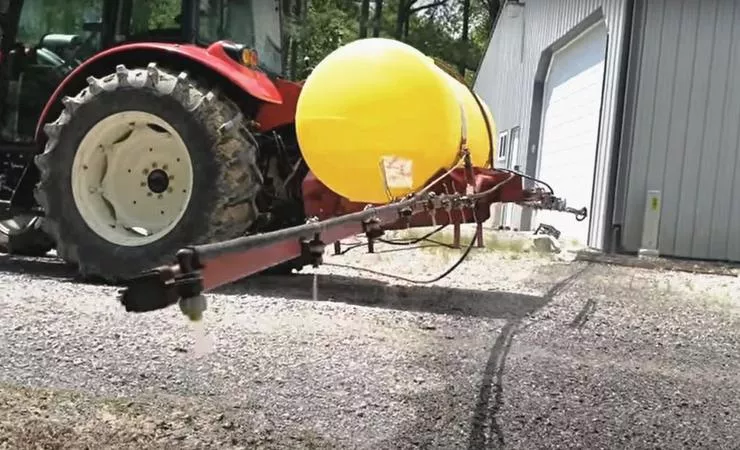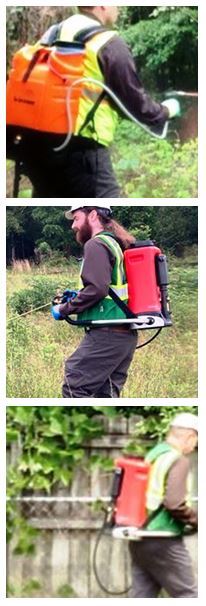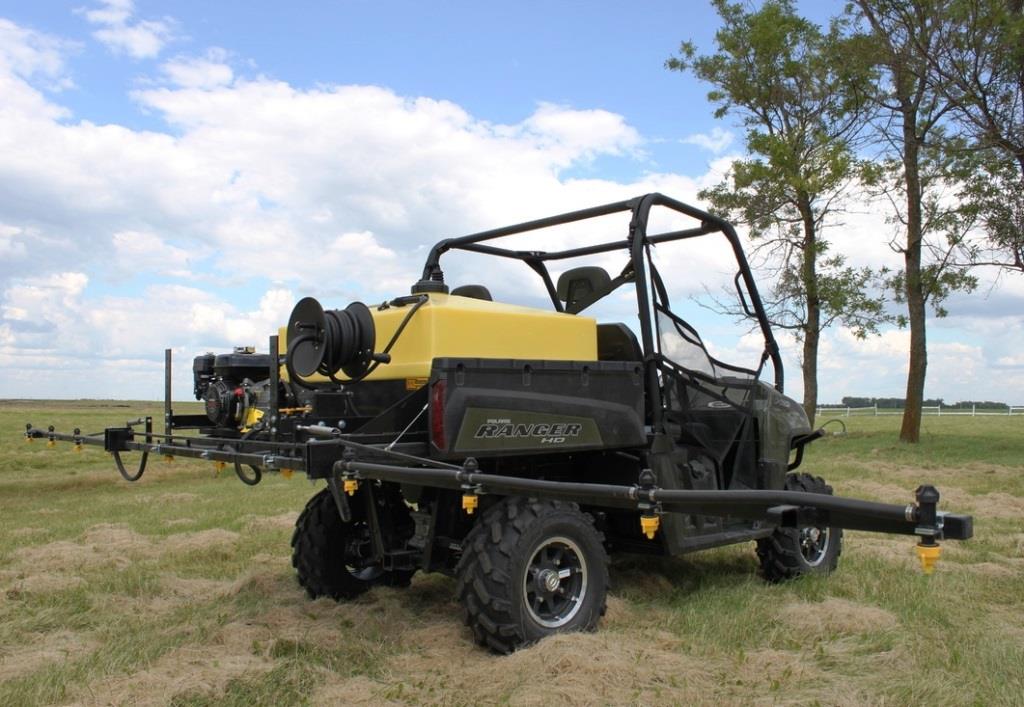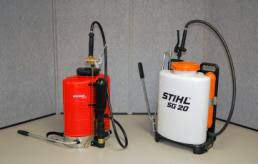
Spraying Efficiency: Sprayers for Vegetation Management

Sprayer Components
Despite their variety, all sprayers share fundamental components that are meant to deliver fast and uniform liquid application.
These parts include the spray nozzle, liquid tank, sprayer pump, and pressure regulator. However, each sprayer style caters to specific tasks accommodating varying conditions and requirements.
Commercial Backpack & Truck Mounted Sprayers
Commercial sprayers used in vegetation management consist of several key components that ensure precision and durability. These include a standard or high-capacity tank, usually made of corrosion-resistant materials (plastic or stainless steel), for holding large volumes of herbicide and its carrier - either water or oil based liquid. The pump, typically a diaphragm or piston type, for consistent pressure and flow rate, which is essential for effective application. Nozzle systems, such as adjustable, fan, and cone nozzles, offer various spray patterns suited to different vegetation control tasks. Agitators inside the tank keep the chemical mixture well-blended, ensuring uniform application. Pressure regulators and gauges provide the user visibility into spray pressure, while filtration systems prevent clogging and protect the equipment. Additionally, commercial sprayers feature industrial hoses and wands, ergonomic controls, and sometimes integrated GPS technology for precise targeting and record-keeping, improving the accuracy and efficiency of vegetation management.

Backpack and Handheld Sprayers
Handheld and backpack sprayers are essential tools for a variety of applications, from private gardens to large industrial sites. These sprayers are known for their lightweight design, ease of use, and versatility, making them ideal for tasks such as herbicide application, weed control, spot treatment, and small-scale blanket spraying. The backpack sprayer, in particular, is a self-contained unit with a tank and pump that can hold up to 5 gallons. It can be carried on the back of the applicator, making it highly mobile and convenient for extensive use in parks, orchards, and right-of-way areas.
Professional Backpack Sprayers
Professional models of backpack sprayers often come with advanced features like mechanical agitators and pressure regulators. They can be equipped with a variety of nozzles, including short booms for broadcast treatments and adjustable cone nozzles for precise applications. These sprayers are particularly effective for treating individual brush plants and for basal and cut surface applications. They operate quietly and are efficient for targeting small areas with low numbers of undesirable plants. Calibration is essential for ensuring consistent application, especially when dealing with varying operator speeds and maintaining steady pressure during use. This ensures that the spray is applied evenly, whether treating foliage or stems on a volume-to-volume basis.
Trolley (Pull Behind) Sprayers
Trolley sprayers come in push or pull versions and are suitable for spot spraying or boom spraying with attached broadcast nozzles. These models vary in capacity, with smaller ones ideal for commercial sites and larger ones suited for fence lines and industrial jobs. Most trolley sprayers feature rechargeable lithium-ion batteries, offering consistent pressure and output for spot and boom spraying.
Tow-Behind Sprayers
Mounted on trailer frames and towed behind vehicles like quads or UTVs, tow-behind sprayers are versatile tools for spot spraying, wide-area spraying, or boom spraying. They're particularly useful for large industrial projects or park settings, offering efficient herbicide dispersion over significant areas.

UTV Sprayers
UTV sprayers are compact units designed to fit into the back of UTVs, side by sides, or gators. These sprayers are ideal for navigating tough terrains and are used primarily for spot spraying weeds or boom spraying for larger areas. Compact and low-profile, UTV sprayers are mobile and efficient, making them essential for vegetation management programs on varied terrain.
Field Sprayers
Field sprayers are larger units designed for covering extensive areas or heavy weed infestations. They range from UTV-sized units to larger trailer sprayers, catering to different scale field spraying requirements.
Choosing the right sprayer is essential for efficient vegetation management. Each type offers unique benefits suited to specific applications, ensuring optimal performance and results. Whether for small-scale spot spraying or large-scale field spraying, there's a sprayer to meet every need.
Backpack Sprayers for Industrial Vegetation Management and Weed Control
When it comes to industrial vegetation management and commercial weed control, having the right backpack sprayer is essential. Not only do these sprayers help increase efficiency, but they also ensure precision and accuracy in applying herbicides or pesticides. But with a variety of options available, it can be difficult to determine which one is best suited for your needs.
In this post, we will look at the various features and accessories to consider when selecting a backpack sprayer for industrial vegetation management use.
Pump Types of Commercial Backpack Sprayers
The first thing to consider when selecting a backpack sprayer is the type of pump. “Knapsack Sprayers” as they are also called in some parts of the world, are the most common and usually feature diaphragm pumps or piston pumps. Diaphragm pumps are less complex and require less maintenance, however, you must make sure the diaphragm material is resistant to the chemical or solvent you plan to use. Piston pumps are more durable; however, they are more complex and require more maintenance.
Commercial Vegetation Control And Proper Pressure Regulation
To ensure the backpack sprayer is correctly calibrated, it's essential to maintain a constant and uniform pressure. Some sprayers are equipped with built-in valves to regulate this pressure, while others feature pressure gauges on the handle. Both are acceptable as long as you maintain uniform pressure. The lower cost options on the market are unregulated and also lack a gauge so it is up to the operator to determine the appropriate pressure to maintain by the frequency of pumping during the spraying operation. These ungauged units are primarily utilized for low precision and less sensitive sites or chemicals where precise product output isn’t necessary, and mere estimation is sufficient. At VegClear our applicators use only precisely calibrated spray equipment, regardless of the client requirements.
Availability of Industrial Vegetation Control Nozzles and Spray Guns
Before purchasing a backpack sprayer, it's important to make sure it is compatible with different spray tips, booms, shielded spray wands, and other accessories. The greater the variety of attachments you can use, the more versatile your sprayer will become.
Wand and Boom Applications
Spray booms, for example, increase the area you spray during each pass through the field. This saves you time and effort. Booms are available in many configurations. They may be oriented vertically for spraying along the height of roadside trees or horizontally for field or bare ground spraying. They’re available preassembled, or you can build one for a particular purpose.
Weed Control Sprayer Tank Volume
Most off the shelf sprayer capacities range from 2 up to 5.5 gallons. You must decide how much weight you want to carry (water weighs a little over eight pounds per gallon). The tank should have an easy-to-read volume gauge printed or embossed along the side. Typically it’s best to go ahead and acquire the largest sprayer available for your application and fill the tank according to the amount of weight you’re able to carry and/or the maximum estimated mix you will be applying. This allows for more versatility down the road, but still useable for smaller applications and light loads.
Other Industrial Backpack Sprayer Features
Additional features to look for in a backpack sprayer include a pumping lever that is in a comfortable position, adjustable straps for better balance and comfort, durable and reinforced hoses with secure attachment to the tank, and a large filling hole with various sized screens and filters, with a tight-fitting lid.
It’s also important to make sure the wand and hand grip are comfortable and easy to remove and clean. This helps reduce clogging at the nozzle and makes it easier to maintain constant pressure while operating the pump. Certain applications may call for changing the wand or grip to modify the spray patterns. Be sure your sprayer of choice has interchangeable spray gun options should you require this level of versatility.
By understanding the features and accessories available, you can ensure you get the most out of your backpack sprayer. With the right backpack sprayer, you can optimize efficiency, accuracy, and precision. This is essential for achieving optimal results in industrial vegetation management and commercial weed control.


Choosing the ideal backpack sprayer in involves careful consideration of various factors and your specific requirements. Different applications demand distinct variations in backpack sprayers, tips & nozzles, making it crucial to weigh the following factors:
1. Pressure: Selecting a backpack sprayer with sufficient pressure is paramount. The pressure directly influences the uniformity of the spray pattern, affecting the coverage of the targeted area. A consistent spray pattern ensures efficient application, particularly when dealing with tasks such as crop fertilization or insect treatment.
2. Flow Rate: The pump plays a pivotal role in regulating the flow rate, representing the volume of fluid passing through the wand and nozzle. Backpack sprayers may offer a range of flow rates or have a singular setting. Modifying the flow rate to your specific needs enhances the precision of application, optimizing the effectiveness of the sprayer.
3. Pump Type: The choice between hand-powered and electric pumps significantly impacts functionality and ease of use. Hand-powered backpack sprayers are generally more affordable but may be less user-friendly. In contrast, electric pumps offer convenience and efficiency, making them a preferred choice for those seeking time-effective solutions. The decision between the two depends on factors such as budget constraints and the intended use, whether for personal or commercial purposes.
4. Comfort: Given that spraying tasks often span extended periods, the comfort of the chosen backpack sprayer is crucial. Whether you're tending to your garden or working in a pest control capacity, a comfortable sprayer ensures ease of wear throughout the duration of your activities. Prioritizing comfort becomes especially relevant for tasks that require hours of continuous use.
5. Size: Considering the size of the tank is vital when selecting a backpack sprayer. The appropriate tank size depends on the area to be sprayed. For larger areas, opting for a larger tank allows for the preparation of a single batch of chemicals, reducing the need for frequent refills. This consideration streamlines the spraying process, enhancing overall efficiency.
The process of choosing a backpack sprayer in involves a thoughtful evaluation of pressure, flow rate, pump type, comfort, and size. By aligning these factors with your specific needs and preferences, you can ensure that the selected backpack sprayer is not only effective but also customized to enhance your overall user experience.